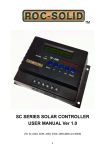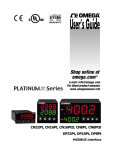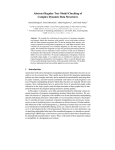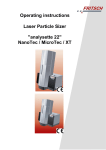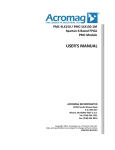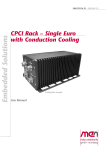Download Hardware Reference and Installation Manual C²I² Systems Dual 4
Transcript
CCII Systems (Pty) Ltd Registration No. 1990/005058/07 C ommunications C omputer I ntellig ence I nteg ration Hardware Reference and Installation Manual for the C²I² Systems Dual 4 Gbps Fibre Channel PMC Adapter C²I² Systems Document No. CCII/FC/6-MAN/005 Document Issue 1.0 Issue Date 2009-01-19 Print Date 2009-01-19 File Name P:\Fibrechn\TECH\MAN\CFCMAN05.WPD Distribution List No © C²I² Systems The copyright of this document is the property of C²I² Systems. The document is issued for the sole purpose for which it is supplied, on the express terms that it may not be copied in whole or part, used by or disclosed to others except as authorised in writing by C²I² Systems. Document prepared by [and for] C²I² Systems, Cape Town Amendment History Issue Description Date ECP No. 0.1 Initial Revision. 2009-01-09 - 1.0 Baseline. 2009-01-19 - CCII/FC/6-MAN/005 P:\Fibrechn\TECH\MAN\CFCMAN05.WPD 2009-01-19 Issue 1.0 Page iii of v Contents 1. Scope . . . . . . . . . . . . . . . . . . . . . . . . . . . . . . . . . . . . . . . . . . . . . . . . . . . . . . . . . . . . . . . . . . . 2 1.1 1.2 1.3 2. Applicable and Reference Documents . . . . . . . . . . . . . . . . . . . . . . . . . . . . . . . . . . . . . . . . . 3 2.1 2.2 3. 3.3 PMC Connectors . . . . . . . . . . . . . . . . . . . . . . . . . . . . . . . . . . . . . . . . . . . . . . . . . . . . . . . . . . . . . . . . . . . . . 9 SFF Fibre Optic Transceivers . . . . . . . . . . . . . . . . . . . . . . . . . . . . . . . . . . . . . . . . . . . . . . . . . . . . . . . . . . . 9 Hardware Installation . . . . . . . . . . . . . . . . . . . . . . . . . . . . . . . . . . . . . . . . . . . . . . . . . . . . . . 10 5.1 5.2 5.3 6. Hardware Features . . . . . . . . . . . . . . . . . . . . . . . . . . . . . . . . . . . . . . . . . . . . . . . . . . . . . . . . . . . . . . . . . . . 4 Architecture . . . . . . . . . . . . . . . . . . . . . . . . . . . . . . . . . . . . . . . . . . . . . . . . . . . . . . . . . . . . . . . . . . . . . . . . . 4 3.2.1 PMC Interface . . . . . . . . . . . . . . . . . . . . . . . . . . . . . . . . . . . . . . . . . . . . . . . . . . . . . . . . . . . . . . . . . 5 3.2.2 Serial EEPROM . . . . . . . . . . . . . . . . . . . . . . . . . . . . . . . . . . . . . . . . . . . . . . . . . . . . . . . . . . . . . . . 5 3.2.3 Embedded Processor . . . . . . . . . . . . . . . . . . . . . . . . . . . . . . . . . . . . . . . . . . . . . . . . . . . . . . . . . . . 5 3.2.4 SSRAM Memory . . . . . . . . . . . . . . . . . . . . . . . . . . . . . . . . . . . . . . . . . . . . . . . . . . . . . . . . . . . . . . . 6 3.2.5 Flash ROM . . . . . . . . . . . . . . . . . . . . . . . . . . . . . . . . . . . . . . . . . . . . . . . . . . . . . . . . . . . . . . . . . . . 6 3.2.6 Small Form-factor (SFF) Fibre Optic Transceivers . . . . . . . . . . . . . . . . . . . . . . . . . . . . . . . . . . . . . 6 3.2.7 Indicators . . . . . . . . . . . . . . . . . . . . . . . . . . . . . . . . . . . . . . . . . . . . . . . . . . . . . . . . . . . . . . . . . . . . 6 General Features Description . . . . . . . . . . . . . . . . . . . . . . . . . . . . . . . . . . . . . . . . . . . . . . . . . . . . . . . . . . . 8 3.3.1 Simple Auto Speed Negotiation . . . . . . . . . . . . . . . . . . . . . . . . . . . . . . . . . . . . . . . . . . . . . . . . . . . 8 3.3.2 Redundant Management . . . . . . . . . . . . . . . . . . . . . . . . . . . . . . . . . . . . . . . . . . . . . . . . . . . . . . . . 8 3.3.3 Diagnostics . . . . . . . . . . . . . . . . . . . . . . . . . . . . . . . . . . . . . . . . . . . . . . . . . . . . . . . . . . . . . . . . . . . 8 3.3.4 Link Controllers . . . . . . . . . . . . . . . . . . . . . . . . . . . . . . . . . . . . . . . . . . . . . . . . . . . . . . . . . . . . . . . . 8 I/O Interface Description . . . . . . . . . . . . . . . . . . . . . . . . . . . . . . . . . . . . . . . . . . . . . . . . . . . . 9 4.1 4.2 5. Applicable Documents . . . . . . . . . . . . . . . . . . . . . . . . . . . . . . . . . . . . . . . . . . . . . . . . . . . . . . . . . . . . . . . . . 3 Reference Documents . . . . . . . . . . . . . . . . . . . . . . . . . . . . . . . . . . . . . . . . . . . . . . . . . . . . . . . . . . . . . . . . . 3 Functional Description . . . . . . . . . . . . . . . . . . . . . . . . . . . . . . . . . . . . . . . . . . . . . . . . . . . . . 4 3.1 3.2 4. Identification . . . . . . . . . . . . . . . . . . . . . . . . . . . . . . . . . . . . . . . . . . . . . . . . . . . . . . . . . . . . . . . . . . . . . . . . . 2 System Overview . . . . . . . . . . . . . . . . . . . . . . . . . . . . . . . . . . . . . . . . . . . . . . . . . . . . . . . . . . . . . . . . . . . . . 2 Document Overview . . . . . . . . . . . . . . . . . . . . . . . . . . . . . . . . . . . . . . . . . . . . . . . . . . . . . . . . . . . . . . . . . . . 2 The Adapter Kit . . . . . . . . . . . . . . . . . . . . . . . . . . . . . . . . . . . . . . . . . . . . . . . . . . . . . . . . . . . . . . . . . . . . . 10 Handling Instructions . . . . . . . . . . . . . . . . . . . . . . . . . . . . . . . . . . . . . . . . . . . . . . . . . . . . . . . . . . . . . . . . . 10 Installation of the Adapter . . . . . . . . . . . . . . . . . . . . . . . . . . . . . . . . . . . . . . . . . . . . . . . . . . . . . . . . . . . . . 10 5.3.1 Step 1. Prepare the Host Carrier Card (HCC) . . . . . . . . . . . . . . . . . . . . . . . . . . . . . . . . . . . . . . . 10 5.3.2 Step 2. Install the Adapter onto Host Carrier Card . . . . . . . . . . . . . . . . . . . . . . . . . . . . . . . . . . . . 10 5.3.3 Step 3. Securing the FC Adapter . . . . . . . . . . . . . . . . . . . . . . . . . . . . . . . . . . . . . . . . . . . . . . . . . 11 5.3.4 Step 4. Attach the Fibre Optic Cabling . . . . . . . . . . . . . . . . . . . . . . . . . . . . . . . . . . . . . . . . . . . . . 11 Programming Interface . . . . . . . . . . . . . . . . . . . . . . . . . . . . . . . . . . . . . . . . . . . . . . . . . . . . 13 6.1 6.2 6.3 PMC Addressing . . . . . . . . . . . . . . . . . . . . . . . . . . . . . . . . . . . . . . . . . . . . . . . . . . . . . . . . . . . . . . . . . . . . 13 Multifunction PMC . . . . . . . . . . . . . . . . . . . . . . . . . . . . . . . . . . . . . . . . . . . . . . . . . . . . . . . . . . . . . . . . . . . 13 Host Interface Registers . . . . . . . . . . . . . . . . . . . . . . . . . . . . . . . . . . . . . . . . . . . . . . . . . . . . . . . . . . . . . . 13 Annexure A . . . . . . . . . . . . . . . . . . . . . . . . . . . . . . . . . . . . . . . . . . . . . . . . . . . . . . . . . . . . . . . . 15 Functional Specifications . . . . . . . . . . . . . . . . . . . . . . . . . . . . . . . . . . . . . . . . . . . . . . . . . . . . . . . . . . . . . . . . . . . . 15 CCII/FC/6-MAN/005 P:\Fibrechn\TECH\MAN\CFCMAN05.WPD 2009-01-19 Issue 1.0 Page iv of v Abbreviations and Acronyms ANSI API ASIC BER CCII CMC CPU EEPROM EMC END FC FC-AL-2 FCP Gbps HCC I/O ID INT IOC IP Kb LC MB MHz MPI nm OS PC PCB PCI PCI-X PMC RAM ROM SCSI SFF SIG SSRAM TCP TCP/IP VPD WWN x86 American National Standards Institute Application Programming Interface Application Specific Integrated Circuit Bit Error Rate C²I² Systems Common Mezzanine Card Central Processing Unit Electrically Erasable Programmable Read Only Memory Electromagnetic Compatibility Enhanced Network Device Fibre Channel Fibre Channel Second Generation Arbitrated Loop Fibre Channel Protocol Gigabit per second Host Carrier Card Input / Output Identification Interrupt I/O Controller Internet Protocol Kilobit Lucent Connector Megabyte Megahertz Message Passing Interface nanometre Operating System Personal Computer Printed Circuit Board Peripheral Component Interconnect Peripheral Component Interconnect - eXtended PCI Mezzanine Card Random Access Memory Read Only Memory Small Computer System Interface Small Form Factor Special Interest Group Synchronous Static Random Access Memory Transfer Control Protocol Transfer Control Protocol (over) Internet Protocol Vendor Product Data World Wide Name Intel x86 Architecture CCII/FC/6-MAN/005 P:\Fibrechn\TECH\MAN\CFCMAN05.WPD 2009-01-19 Issue 1.0 Page 1 of 15 1. Scope 1.1 Identification This document is the technical reference and installation manual for the C²I² Systems (CCII) Dual 4 Gigabit per second (Gbps) Fibre Channel (FC) Peripheral Component Interconnect (PCI) Mezzanine Card (PMC) Adapter (hereafter simply referred to as the FC PMC Adapter). 1.2 System Overview The FC PMC Adapter is a high-performance Dual 4 Gbps Fibre Channel PMC Adapter. It offers a maximum link speed of 4 Gbps (per channel) over fibre optic media and connects to a host carrier card (HCC) via a 64-bit, 133 MHz PCI-X interface. The FC PMC Adapter provides optimal flexibility by supporting simultaneous Internet Protocol (IP) and Small Computer System Interface (SCSI) protocols on each full duplex 4 Gbps FC link. The FC PMC Adapter integrates an Application Specific Integrated Circuit (ASIC) with three embedded ARM processors which handle all protocol processing and data transfers. This reduces overhead on the host carrier processor to a minimum, thus allowing higher network data throughput. Data transfers to and from the FC PMC Adapter are controlled independently using single channel Bus Mastering or Scatter Gather Mode, over the PMC bus. 1.3 Document Overview The first section in this document gives a functional description and general overview of the hardware features of the CCII Dual 4 Gbps FC PMC Adapter. This is followed by an illustrative layout of the PMC connectors and the user indicators on the FC PMC Adapter. A hardware installation guide with descriptive notes is also given in this section. The last section in this document will be concerned with the Application Programming Interface (API) of the FC PMC Adapter. CCII/FC/6-MAN/005 P:\Fibrechn\TECH\MAN\CFCMAN05.WPD 2009-01-19 Issue 1.0 Page 2 of 15 2. Applicable and Reference Documents 2.1 Applicable Documents 2.1.1 2.1.2 2.1.3 PCI Special Interest Group, PCI Local Bus Specification, Rev. 2.3, Dated 2002-03-29 PCI Special Interest Group, PCI-X Addendum to the PCI Local Bus Specification, Rev. 1.0a, Dated 2000-07-22 CCII/FC/6-MAN/001, User Manual for the C²I² Systems' PMC Fibre Channel END VxWorks Driver 2.2 Reference Documents 2.2.1 CCII/FC/6-MAN/002, Procedure for Firmware Download and EEPROM Configurations for the C²I² Systems Fibre Channel PMC Adapter IEEE Std 1386-2001, IEEE Standard for a Common Mezzanine Card (CMC) Family, Dated 2001-06-14 IEEE Std 1386.1-2001, IEEE Standard Physical and Environmental Layers for PCI Mezzanine Cards ( PMC), Dated 2001-06-14 2.2.2 2.2.3 CCII/FC/6-MAN/005 P:\Fibrechn\TECH\MAN\CFCMAN05.WPD 2009-01-19 Issue 1.0 Page 3 of 15 3. Functional Description This section provides a technical hardware overview of the CCII Dual 4 Gbps FC PMC Adapter. 3.1 Hardware Features The following is a list of some of the FC PMC Adapter's hardware features : C C C C C C C C C C 3.2 Highly integrated, full duplex Dual Channel Fibre Channel Input/Output (I/O) Processor Dual 4 Gbps FC links 64-bit/133 MHz host PMC bus (backward compatible with 32-bit/33 MHz modes) Embedded 32-bit ARM processors Integrated Bit Error Rate (BER) link testing Full simultaneous Target and Initiator operations Implements a common Message Passing Interface (MPI) Firmware, stored in Flash Read Only Memory (ROM), supports up to 2000 concurrent host commands Serial Electrically Erasable Programmable Read Only Memory (EEPROM) for storing factory settings PCI-X 1.0a compliant (backward compatible with PCI 2.3 systems) Architecture A functional block diagram of the FC PMC Adapter is depicted in Figure 1 : Clock (106,25 MHz) FC Channel 0 32/64 2 SFF Fibre Optic Transceiver 2 PMC Bus Clock (106,25 MHz) Integrated Transceiver LSIFC949X Integrated Transceiver Memory Controller 2 SFF Fibre Optic Transceiver 2 FC Channel 1 PMC Bus-Mode Logic 32 2 SSRAM (1 MB min.) Flash ROM (1 MB min.) Serial EEPROM (8 Kb min.) Figure 1 : Fibre Channel PMC Adapter Functional Block Diagram CCII/FC/6-MAN/005 P:\Fibrechn\TECH\MAN\CFCMAN05.WPD 2009-01-19 Issue 1.0 Page 4 of 15 The FC PMC Adapter consists of the following functional elements : C C C C C C C 3.2.1 PMC Interface Serial EEPROM Processor Synchronous Static Random Access Memory (SSRAM) Memory FLASH ROM SFF Fibre Optic Transceivers Indicators PMC Interface The PMC interface allows the FC PMC Adapter to be fitted on any host carrier card conforming to the PMC Specification. The FC PMC Adapter can interface directly to a host's 64-bit/133 MHz PMC bus (or a standard PC's PCI-X bus, via a special PMC-to-PCI converter, which can be ordered seperately) and is backward compatible with 32-bit/33/66/100 MHz (PCI 2.3) modes of operation. The system interface is designed to minimize the amount of time spent on the PCI bus for non-data moving activities such as initialisation, command and error recovery. The interface consists of a PMC bus interface and a number of bus-mode signals. On the FC PMC Adapter the bus-mode signalling is implemented using dedicated logic circuitry, which prevents the card from operating on a non-PMC bus and allows the host to sense the presence of a card in a PMC slot. Refer to Paragraph 5.2 of the PMC Specification [Par. 2.2.3] for a complete description of the PMC interface signals and to Paragraph 6.4 of the Common Mezzanine Card (CMC) Specification [Par. 2.2.2 ] for information on bus-mode signalling. 3.2.2 Serial EEPROM The serial EEPROM stores nonvolatile data for the embedded processor, such as the World Wide Name (WWN), Vendor Product Data (VPD), and other vendor specific information. The serial EEPROM also stores the configuration settings, such as the link speed setting. The serial EEPROM data is programmed by the firmware, therefore the firmware must be downloaded and running before the serial EEPROM can be programmed. The serial EEPROM has an 8 Kb capacity. PMC configuration information is also stored in the serial EEPROM. The information in the EEPROM is loaded by the PMC bridge when the board is reset (either at power-up or during use). The EEPROM must be programmed with valid values before the FC PMC Adapter will be plug-and-play compatible. The CCII FC Adapter uses the default configuration space values as specified in Table 1: Table 1 : PCI Configuration Data 3.2.3 Offset Default Value 0x000 0x1000 0x002 0x0622 or 0x0623 0x010 - Description PCI SIG allocated Vendor Identifier Device Identifier Base Address of FC Adapter assigned by Host Embedded Processor The FC PMC Adapter uses the LSI Logic FC-949X ASIC, hereafter referred to as the Input/Output (I/O) Controller (IOC), to control all system interface and message transport functionality. This frees the host Central Processing Unit (CPU) for other processing activity and improves overall I/O CCII/FC/6-MAN/005 P:\Fibrechn\TECH\MAN\CFCMAN05.WPD 2009-01-19 Issue 1.0 Page 5 of 15 performance. The IOC and associated firmware have the ability to manage an I/O transaction from start to finish without any host intervention. The IOC also handles the Message Passing Interface. 3.2.4 SSRAM Memory The primary function of this memory is to store data structures used by the IOC to manage exchanges and transmit and receive queues. The Random Access Memory (RAM) also stores part of the run time image of the IOC firmware, such as initialisation and error recovery code. The IOC uses a 32-bit non-multiplexed memory bus to access the SSRAM. This memory bus has the capability to address up to 4 MB of SSRAM. The IOC firmware also supports optional wide parity error detection. This option is configurable, and is specified as a serial EEPROM parameter. The amount of SSRAM (1 MB) determines the maximum number of outstanding Request Messages (1024). This roughly equates to the maximum number of outstanding I/O requests pending in the IOC. 3.2.5 Flash ROM The memory controller in the IOC also manages a Flash ROM. The Flash ROM is used to store the firmware for the IOC. In an Intel x86 Architecture (x86) Personal Computer (PC) environment the Flash can also store the Interrupt (INT) 0x13 boot software. The Flash ROM is accessed using the upper eight bits of the Memory Interface. Refer to the programming manual [Par. 2.2.1] for procedures regarding the programming of the Flash ROM. 3.2.6 Small Form-factor (SFF) Fibre Optic Transceivers The FC PMC Adapter connects to the external FC LAN via duplex fibre optic cabling. These connect to the onboard transceivers via mating LC-style duplex fibre optic connectors. 3.2.7 Indicators The FC PMC Adapter provides five Front Panel Indicators and ten Printed Circuit Board (PCB) Mounted Indicators to report hardware and software status. Table 2 below describes the meaning of each of these indicators : Table 2 : Indicator Description Indicator F0, F1 Act0, Act1 H Description Front Panel Indicator : Channel 0, Channel 1 : Link Failure (Amber) Front Panel Indicator : Channel 0, Channel 1 : Transmit / Receive Activity (Green) Front Panel Indicator : Adapter Heart Beat (Green) LD9, LD12 PCB Mounted Indicator : Channel 0, Channel 1 : 1 Gbps Link Speed (Green) LD8, LD11 PCB Mounted Indicator : Channel 0, Channel 1 : 2 Gbps Link Speed (Green) LD7, LD10 PCB Mounted Indicator : Channel 0, Channel 1 : 4 Gbps Link Speed (Green) LD1, LD2 PCB Mounted Indicator : Channel 0, Channel 1 : FC Link Bypassed (Red) LD3 PCB Mounted Indicator : 1,2 V Power Supply Failure (Red) LD4 PCB Mounted Indicator : 3,3 V Power Supply Failure (Red) CCII/FC/6-MAN/005 P:\Fibrechn\TECH\MAN\CFCMAN05.WPD 2009-01-19 Issue 1.0 Page 6 of 15 Refer to Figure 2 below for the location of the Front Panel Indicators and Figure 3 for that of the PCB Mounted Indicators. The PCB Mounted Indicators are found on the Secondary Side of the adapter (the visible side, when installed in a PMC site on an HCC). Figure 2 : Front Panel Indicators Figure 3 : PCB Indicator Locations During Firmware initialisation, the indicators may also have a secondary function. The indicators may blink out a fault code in case of a hardware or software failure. In case of such a fault code being displayed, please record it and contact C²I² Systems for further support. CCII/FC/6-MAN/005 P:\Fibrechn\TECH\MAN\CFCMAN05.WPD 2009-01-19 Issue 1.0 Page 7 of 15 3.3 General Features Description The CCII 4 Gbps FC PMC Adapter is used to connect a host to a high speed FC Link. The Fibre Channel Protocol (FCP) ANSI Standard, FC Private Loop Direct Attach and Fabric Loop are supported with the use of a sophisticated firmware implementation. Although optimised for use with a 64-bit PMC interface to communicate with the system CPU(s) and memory, the IOC also supports a 32-bit PMC environment. The system interface to the IOC is designed to minimize the amount of PMC bandwidth required to support I/O requests. A packetised message passing interface is used to reduce the number of single cycle PMC bus cycles. All FC data traffic on the PMC bus occurs with zero wait bursts across the PMC bus. The intelligent IOC architecture allows the system to specify I/O commands at the command level. The IOC manages I/Os at the Frame, Sequence and Exchange level. Error detection and I/O retries are also handled by the IOC, allowing the system to offload part of the exception handling work from the system software driver. 3.3.1 Simple Auto Speed Negotiation Backward compatibility with 1 and 2 Gbps FC devices is maintained through the use of a Simple Auto Speed Negotiation Algorithm. After a power-on, loss of signal, or loss of word synchronization for longer than a certain amount of time, the IOC will perform this operation to determine whether a point-to-point device or all the devices on a loop are either 1, 2 or 4 Gbps capable devices. 3.3.2 Redundant Management The IOC supports two PMC functions and FC ports, which improves performance and provides a redundant path in highly-availability systems which require failover capabilities. In case of a Link Failure, the IOC architecture allows the Operating System (OS) driver to support automatic failover, without the need for IOC intervention. 3.3.3 Diagnostics The IOC provides the capabilities to do a simplified Link Check BER test on the link for diagnostic purposes. In a special test mode the controller can transmit and verify a programmed data pattern for link evaluation. 3.3.4 Link Controllers The integrated link controller is Fibre Channel Second Generation Arbitrated Loop (FC-AL-2) (Rev. 7.0) compatible and performs all link operations. The controller monitors the Link State and strictly adheres to the Loop Port State Machine ensuring maximum system interoperability. The link control interfaces to the integrated transceivers. CCII/FC/6-MAN/005 P:\Fibrechn\TECH\MAN\CFCMAN05.WPD 2009-01-19 Issue 1.0 Page 8 of 15 4. I/O Interface Description This section describes the I/O interfaces found on the FC PMC Adapter, being the the PMC bus connectors and the fibre optic transceivers, as shown in Figure 4 below : Figure 4 : I/O Interface Locations 4.1 PMC Connectors The FC PMC Adapter's three PMC connectors, P11, P12 and P13, are identified in Figure 4. Please refer to the PMC Specification [Par. 2.2.2] for a more detailed description of the PMC pinouts. The adapter is keyed for 3,3 V PMC I/O signalling and should only be plugged into an HCC PMC slot that supports 3,3 V PMC I/O signalling. 4.2 SFF Fibre Optic Transceivers The FC PMC Adapter incorporates two SFF Fibre Optic Transceivers for direct connection to the Fibre Channel LAN. The FC PMC Adapter comes standard with two 850 nm Fibre Optic Transceivers (../SX part number), for use with multi-mode fibre optic media. Single-mode Fibre Optic Transceivers are also available on special request (../LX part number). These transceivers accept standard LC-style fibre optic connectors. CCII/FC/6-MAN/005 P:\Fibrechn\TECH\MAN\CFCMAN05.WPD 2009-01-19 Issue 1.0 Page 9 of 15 5. Hardware Installation This section will describe the procedure for installing the CCII FC PMC Adapter on an HCC. 5.1 The Adapter Kit The adapter kit consists of the following items : C C C C C C Cardboard Package Antistatic Protective Bag The FC PMC Adapter A Paper Envelope containing an Installation Diskette PMC Fasteners and Standoffs This Installation Guide If any item is missing or damaged, contact C²I² Systems. Please refer to the Release Notes on the diskette for the latest information regarding this product. 5.2 Handling Instructions 5.3 Installation of the Adapter The installation of the CCII FC PMC Adapter will be illustrated in the following steps. Note that the installation shown here was done on an arbitrary HCC to demonstrate the general steps for installing the Front Panel I/O FC PMC Adapter. During the installation process and handling of the FC PMC Adapter, all relevant antistatic precautions should be observed to protect both the adapter as well as the HCC. These include working on an antistatic workstation whilst being electrically grounded by means of an antistatic wristband, ankle strap or similar device. 5.3.1 Step 1. Prepare the Host Carrier Card (HCC) Observe all relevant antistatic precautions and remove the HCC from it's antistatic bag and place on an antistatic workstation. Please refer to the HCC's Hardware Installation Manual for any special care instructions relevant to that particular HCC. 5.3.2 Step 2. Install the Adapter onto Host Carrier Card Remove the FC PMC Adapter from the antistatic bag and ensure that the bezel and standoffs are properly secured and the elastic electromagnetic compatibility (EMC) gasket is installed on the bezel. Proceed with the installation of the FC PMC Adapter as shown in Figure 5, ensuring that the female PMC connectors on the FC PMC Adapter align properly with the male PMC connectors on the HCC before pressing down on the adapter. Figure 5 : FC PMC Adapter Installation CCII/FC/6-MAN/005 P:\Fibrechn\TECH\MAN\CFCMAN05.WPD 2009-01-19 Issue 1.0 Page 10 of 15 5.3.3 Step 3. Securing the FC Adapter The FC PMC Adapter is secured to the HCC by four M2.5 screws (supplied), two of which secure the bezel and the other two the standoffs. This is illustrated in Figure 6 below : Figure 6 : HCC-side Screw Locations 5.3.4 Step 4. Attach the Fibre Optic Cabling Care should be taken never to look directly into the path of a Fibre Optic Transceiver's laser beam, to avoid possible eye damage. It is thus recommended that fibre optic cabling should only be connected to / disconnected from the FC PMC Adapter whilst the HCC is powered down. After removing the transceiver's protective dust cap, a mating LC-style connector is plugged into the transceiver with sufficient positive force to engage the connector's locking mechanism. Figure 7 shows a FC PMC Adapter with duplex multi-mode fibre optic cabling plugged into both the FC0 and FC1 transceivers. CCII/FC/6-MAN/005 P:\Fibrechn\TECH\MAN\CFCMAN05.WPD 2009-01-19 Issue 1.0 Page 11 of 15 Figure 7 : FC Adapter with Duplex LC Connectors Attached Unused ports (or any FC PMC Adapters in storage) should always have protective dust caps installed on the fibre optic transceivers. CCII/FC/6-MAN/005 P:\Fibrechn\TECH\MAN\CFCMAN05.WPD 2009-01-19 Issue 1.0 Page 12 of 15 6. Programming Interface 6.1 PMC Addressing There are three types of PMC-defined address spaces : C C C Configuration space Memory space I/O space Configuration space is a contiguous 256 x 8-bit set of addresses dedicated to each "slot" or "stub" on the PMC bus. The host processor uses the PMC configuration space to initialise the FC PMC Adapter. At initialisation time each PMC device is assigned a base address for memory and I/O accesses. 6.2 Multifunction PMC The CCII FC PMC Adapter supports multifunction capability on the PMC bus. Both I/O Controller 0 (IOC 0) and I/O Controller 1 (IOC 1) have identical configuration space memory maps, and most of the data reported in these registers by the host processor are also the same. The only exceptions are the Device Identification (ID), Class Code, Subsystem ID, and Subsystem Vendor ID. The user must do a PMC find based on the Device ID, either (0x0622) or (0x0623), and the Vendor ID (0x1000) to obtain a handle to the device. The base address of the card may then be read from the PMC configuration space at offset (0x010) for the I/O Base Address, or at offset (0x01C) for the Memory Base Address. 6.3 Host Interface Registers The first 128 bytes of PMC Memory 0 address space contains the Host Interface Register Set. The FC PMC Adapter also specifies an I/O Space requirement of 128 bytes of I/O mapped space which the System is required to assign during PMC configuration. The 128 bytes of I/O Space are mapped onto the first 128 bytes of Memory 0 space; providing an alternate access path to the Host Interface Register Set. CCII/FC/6-MAN/005 P:\Fibrechn\TECH\MAN\CFCMAN05.WPD 2009-01-19 Issue 1.0 Page 13 of 15 The Host Interface Register Set is given in Table 3 below : Table 3 : Host Interface Register Set 3 31 2 24 23 CCII/FC/6-MAN/005 P:\Fibrechn\TECH\MAN\CFCMAN05.WPD 1 16 15 Byte 0 8 7 0 (Bit) Doorbell 00h Write Sequence 04h Diagnostic 08h Test Base Address 0Ch Reserved 10h 2Fh Host Interrupt Status 30h Reply Interrupt Mask 34h Reserved 38h 3Fh Request Queue 40h Reply Queue 44h High Priority Request FIFO 48h Reserved 4Ch 7Fh 2009-01-19 Issue 1.0 Page 14 of 15 Annexure A Functional Specifications Designation I/O Connector Grade Media Speed CCII/FC/PMC/2P/FP/COM/SX CCII/FC/PMC/2P/FP/IND/SX CCII/FC/PMC/2P/FP/RGD/SX CCII/FC/PMC/2P/FP/COM/LX CCII/FC/PMC/2P/FP/IND/LX CCII/FC/PMC/2P/FP/RGD/LX Dual SFF/LC Dual SFF/LC Dual SFF/LC Dual SFF/LC Dual SFF/LC Dual SFF/LC Commercial Industrial Ruggedised Commercial Industrial Ruggedised Multi-mode Fibre Multi-mode Fibre Multi-mode Fibre Single-mode Fibre Single-mode Fibre Single-mode Fibre 4 Gbps 4 Gbps 4 Gbps 4 Gbps 4 Gbps 4 Gbps Bus Address Bus Compliancy Interrupts Address Cycle Data Transfer PnP auto selected 64-bit, 133 MHz, backward compatible with 32-bit, 33 MHz PCI Rev. 2.3, PCI-X Rev. 1.0a PCI INT A + B Dual Address Cycle Support Bus Mastering and Scatter Gather PMC Interface Dimensions Single Common Mezzanine Card (CMC) IEEE P1386 compliant (149 mm x 74 mm x 9,8 mm) Mass 110 g +/- 10 g Power Requirements Supply : +5 V, 1,5 A (max) PMC I/O Signalling : +3,3 V Figures according to MIL-HDBK-217F, Parts Count Method: MTBF Environmental Specifications Ground Mobile Tj = 65 C Ta = 45 C 23 000 hrs Naval, Sheltered Tj = 65 C Ta = 40 C 33 000 hrs Airborne, Inhabited Cargo Tj = 75 C Ta = 55 C 29 000 hrs Temperature Commercial Industrial Operating Temp. Storage Temp. 0 C to +55 C -40 C to +85 C -15 C to +75 C -40 C to +85 C ConductionCooled -40 C to +85 C -55 C to +125 C Humidity 0 - 90% 0 - 95% 0 - 95% Shock N/A 30 g peak half sine 11 ms 40 g peak half sine 11 ms Random Vibration N/A 0,04 g²/Hz 15 to 2 KHz 0,1 g²/Hz 15 to 2 KHz Software Drivers • • • • Protocols Fibre Channel/Internet (singular or intermixed): • • VxWorks 5.x, VxWorks 6.x Windows 2000, Windows Server 2003, Windows XP Solaris x86, Solaris SPARC SUSE Linux, Red Hat Linux TCP/IP SCSI Custom Protocols supported (singular or intermixed). CCII/FC/6-MAN/005 P:\Fibrechn\TECH\MAN\CFCMAN05.WPD 2009-01-19 Issue 1.0 Page 15 of 15




















